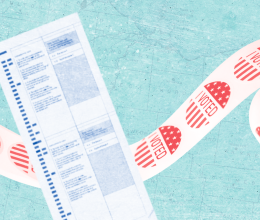Many Ohioans are misinformed about Ohio’s voting laws including who is eligible to vote with a criminal record. These myths are most common among jail officials, local election authorities and in communities with a high population of persons returning from prison. Luckily, the ACLU of Ohio is releasing a jail voting tool kit, entitled “Voting in Jail: An Organizer’s Toolkit,” to empower activists, communities and organizations to combat these myths and educate about their voting rights. Still, many may wonder if detainees are even miseducated about their voting rights at all or if there are significant voting barriers for persons with criminal histories.
Many individuals with records or serving time in jail do not know they have the right to vote.
In the past, election authorities have created some of these barriers. A 2004 report by the Ohio Justice and Policy Center found that many of Ohio’s boards of elections were sending written correspondence to formerly incarcerated individuals that “misstated” or “did not clearly” explain Ohio’s voting laws. The report also found that Ohio’s former Secretary of State, Ken Blackwell, failed to instruct county boards of elections to advise individuals with felony convictions that they could re-register to vote. In Ohio, anyone who is not imprisoned for a felony can vote. This includes people released from prison, awaiting trial, currently on probation or parole, or serving time for a misdemeanor. Once released, people must re-register before voting.
Later in a 2008 assessment, OJPC found that at least nine BOEs were still being unclear with formerly incarcerated individuals regarding their voting rights. Furthermore, a survey of individuals with felony records at the Hamilton and Montgomery Counties APA offices revealed 16 and 19 percent of individuals, respectively, believed their voting rights were not restored. They believed they were only permitted to vote with their probation officer’s permission, could not vote until their probation or parole was completed, or could not vote at all. If another survey were conducted today, the results would be strikingly similar.
Both the 2004 and 2008 findings provide unsurprising evidence that voter registration groups, local organizations and community activists have a lot of work ahead to educate formerly incarcerated individuals, detainees and their families about who qualifies to register and vote. One of the most effective ways to provide this voter education is working directly with jail and election officials to enter county jails and register eligible detainees. While this process may seem daunting, the ACLU of Ohio toolkit provides clear instructions about how to establish relationships with officials, find and train volunteers to work on your campaign and use strategies to enter jails and engage directly with voters.
By embarking on a jail voting campaign, organizers can address the urgent need of educating every Ohioan with a criminal conviction about their voting rights. Even more critical is ensuring individuals detained in jail are not disenfranchised because their local jail and elections officials do not have a registration system in place. Creating a sustainable and reliable jail voting system will also ensure future detainees are not inadvertently disenfranchised and have an equal place in our democracy.
By using this tool kit, activists can increase voter participation in Ohio’s 72 county jails.
If you have always wondered how you could make a difference and speak up for the integrity of our elections, you can do so by helping individuals who are detained in jail register to vote. Learn more at www.acluohio.org/jailvoting.





